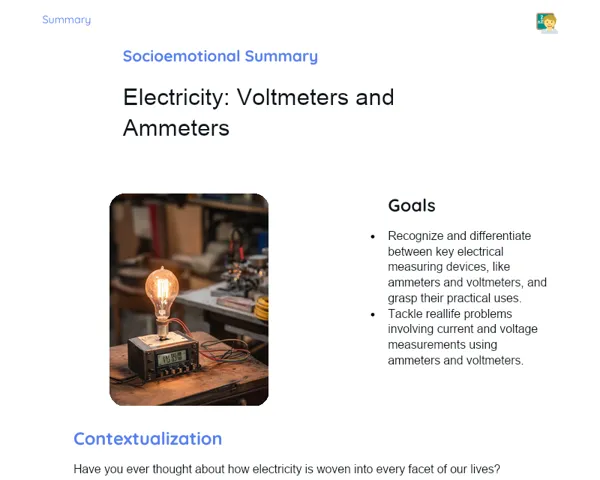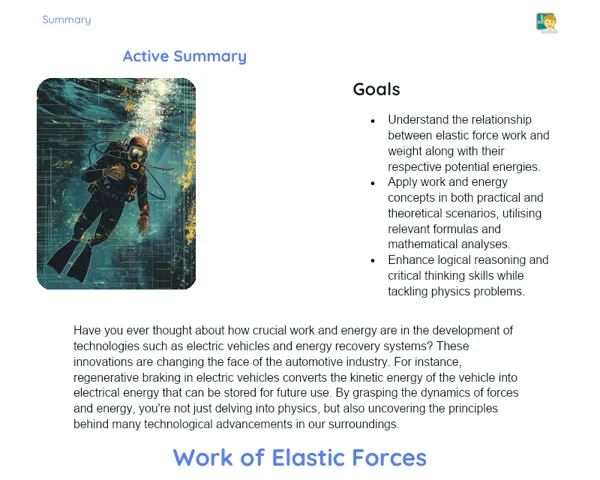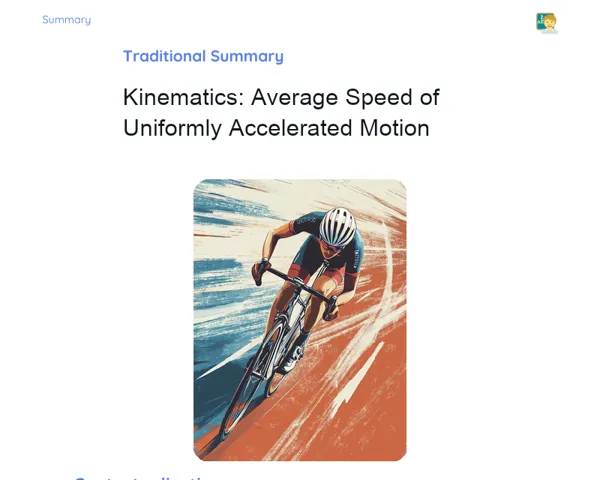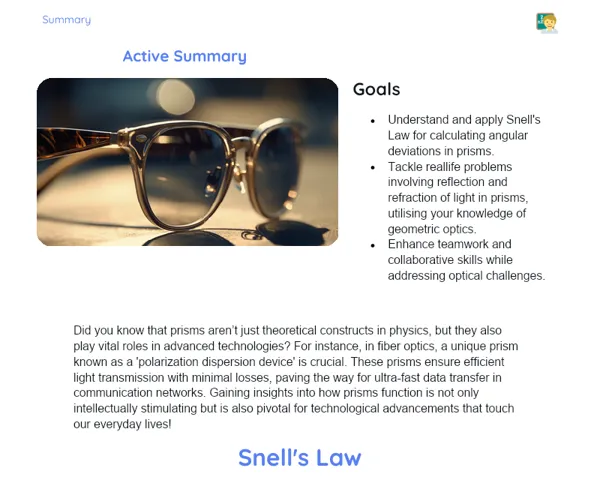Summary Tradisional | Gravitation: Gravitational Acceleration
Contextualization
Gravitation is one of the four primary forces of nature and plays a vital role in how our universe is shaped and maintained. Whether it’s the way an apple falls from a tree or the orbits of planets around the Sun, gravity is the force that keeps all celestial bodies in their designated paths. Sir Isaac Newton laid down the Law of Universal Gravitation in the 17th century, which mathematically explains this force: the attraction between two masses is directly proportional to the product of their masses and inversely proportional to the square of the distance separating them.
Gravitation isn't merely a theoretical concept; it has several significant practical implications. For instance, the gravitational acceleration on Earth’s surface is roughly 9.8 m/s², influencing how objects and living entities move on our planet. Additionally, understanding gravitational acceleration on various planets helps us explore conditions in outer space, which is crucial for our space endeavors and the possibility of colonizing other worlds. In this lesson, we will learn how to apply the Law of Universal Gravitation to find gravitational acceleration in different situations, including how gravity changes with distance.
To Remember!
Law of Universal Gravitation
The Law of Universal Gravitation was introduced by Sir Isaac Newton in the 17th century. It states that every pair of bodies in the universe attracts each other with a force proportional to the product of their masses and inversely proportional to the square of the distance separating them. The mathematical representation of this law is: F = G * (m1 * m2) / r², where F is the gravitational force, G is the gravitational constant (6.674 * 10⁻¹¹ N(m/kg)²), m1 and m2 are the masses of the bodies, and r is the distance between them.
This law is essential for comprehending the movements of celestial bodies and their interactions. It explains why, for example, Earth orbits the Sun and how the Moon orbits Earth. Without this attractive force, planets and satellites would not follow stable orbits and would drift off into space.
The Law of Universal Gravitation also comes in handy when calculating the paths of satellites and spacecraft. Having a firm grasp of this law allows us to accurately predict how objects will move in space, which is vital for successful space missions.
-
Gravitational force relates directly to the product of the masses involved.
-
Gravitational force inversely relates to the square of the distance.
-
The gravitational constant (G) is approximately 6.674 * 10⁻¹¹ N(m/kg)².
Gravitational Acceleration (g)
Gravitational acceleration is the acceleration experienced by an object due to the gravitational pull of a planet or a celestial body. On Earth’s surface, this acceleration is about 9.8 m/s², meaning in a vacuum, an object in free fall will increase its speed by 9.8 meters each second.
This acceleration is derived from the Law of Universal Gravitation and can be calculated using the formula: g = G * M / r², where G is the gravitational constant, M represents the planet’s mass, and r is the distance from the planet’s center to its surface. For Earth, M is roughly 5.97 * 10²⁴ kg and r is about 6.37 * 10⁶ meters.
The gravitational acceleration differs across planets and varies with the distance from the center of the celestial body. For example, on the Moon, gravitational acceleration is nearly 1/6th of what it is on Earth due to its smaller mass and radius.
-
Acceleration on Earth's surface is about 9.8 m/s².
-
The formula to find g is g = G * M / r².
-
Gravitational acceleration varies across different planets and based on distance from the center.
Calculating Gravitational Acceleration on Other Planets
To find gravitational acceleration on other planets, we use the formula derived from the Law of Universal Gravitation: g = G * M / r², where G is the gravitational constant, M is the planet's mass, and r is the planet’s radius. For instance, for Mars, which has a mass of around 6.42 * 10²³ kg and a radius of about 3.39 * 10⁶ meters, we can compute its gravitational acceleration.
By plugging these values into the formula, we get: g = 6.674 * 10⁻¹¹ * 6.42 * 10²³ / (3.39 * 10⁶)², resulting in an approximate value of 3.71 m/s². This indicates that Mars’ gravitational acceleration is less than half of Earth’s, which has notable ramifications for manned and unmanned missions to the red planet.
Calculating gravitational acceleration is pivotal for aerospace engineering as it impacts spacecraft design and mission planning. Understanding gravity on different planets is essential for predicting the scenarios explorers and robotic missions would face.
-
To calculate g on other planets, use g = G * M / r².
-
Gravitational acceleration on Mars is about 3.71 m/s².
-
Calculating g is vital for space missions and aerospace design.
Variation of Gravity with Distance
Gravitational acceleration changes based on how far one is from the center of a planet or celestial body. The formula g = G * M / r² indicates that gravity diminishes as distance (r) increases. For example, at a distance twice that of Earth's radius, gravitational acceleration decreases to one-fourth of what it is at the surface.
Taking Earth's mass as 5.97 * 10²⁴ kg and its radius as 6.37 * 10⁶ meters, we can compute gravitational acceleration at double the radius: g = G * M / (2 * r)², yielding around 2.45 m/s². This highlights a significant decline in gravitational force with an increase in distance.
Understanding this variation is crucial for various applications, such as satellite orbits. Satellites positioned in higher orbits experience reduced gravity, which affects their speed and the energy necessary to keep them in their designated paths.
-
Gravity decreases as the distance from the center increases.
-
Gravitational acceleration at two times Earth's radius is about 2.45 m/s².
-
This concept is important for satellite orbits and space missions.
Key Terms
-
Law of Universal Gravitation: Establishes that the gravitational attraction between two bodies is proportional to the product of their masses and inversely proportional to the square of the distance separating them.
-
Gravitational Acceleration (g): The acceleration due to the force of gravity exerted by a planet or celestial body.
-
Gravitational Constant (G): The constant value used in the Law of Universal Gravitation, roughly 6.674 * 10⁻¹¹ N(m/kg)².
-
Gravitational Force: The attractive force experienced between two masses.
-
Radius of the Earth: The distance from the center of the Earth to its surface, approximately 6.37 * 10⁶ meters.
-
Mass of the Earth: About 5.97 * 10²⁴ kg.
-
Gravity on the Moon: Roughly 1/6th of gravity on Earth.
-
Orbit: The path a body takes around another due to gravitational attraction.
Important Conclusions
In this lesson, we delved into the Law of Universal Gravitation put forth by Sir Isaac Newton, which describes the attractive force between two bodies as directly proportional to the product of their masses and inversely proportional to the square of the distance between them. This law is fundamental in grasping the movement of celestial bodies and their interactions, and also has several practical applications, like calculating satellite and spacecraft trajectories.
We also talked about gravitational acceleration, which is the acceleration experienced by an object due to the gravitational pull of a planet or celestial body. For Earth, this acceleration is approximately 9.8 m/s². Through the formula g = G * M / r², we learned how to compute gravitational acceleration on different planets and see how it changes depending on the distance from the planet's center.
Lastly, we looked at how gravitational acceleration diminishes with increasing distance from the planet's center, and why this understanding is crucial for aerospace engineering and the maintenance of satellite orbits. Grasping these concepts facilitates accurate predictions of how objects move in space, which is vital for space missions and the potential colonization of other planets.
Study Tips
-
Go over the calculations from class to reinforce your understanding of applying the Law of Universal Gravitation.
-
Examine the changes in gravitational acceleration with distance, completing additional exercises for various planets and distances.
-
Read more about the practical uses of gravity in space missions and how gravitational acceleration influences spacecraft design.



